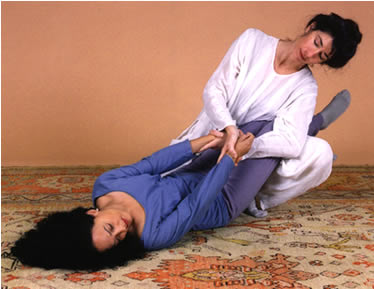Breema
The development of Breema bodywork began in 1980 in a group of several people who came from different schools of bodywork in Oakland (USA). It built on traditional roots, was and is independent of them in focus and development. The aim of this method is the "presence" of the practitioner. In such an atmosphere of presence, the experience of the unity of body, mind and emotions should be possible in addition to the practitioners and the client.
Basics
The Breema bodywork consists of a single ( self - Breema ) and partner exercises that can be performed clothed on a soft pad on the ground. They include elements such as stretching, lean, spreading, holding, and a variety of playful, rhythmic movements that are performed " with the whole body " and at the same time determined and yet gentle. This makes the connection that the person carrying out one's own body, an important role. The mind of the one or practitioner who is usually employed with naming, comparing, judging, etc., gets the task to register your own body in the Breema exercise. " This thinking is embedded in the physical events and amplifies the presence of experience, rather than the experience to comment on. " In the experience of one's own presence, supportive and nurturing quality of the whole existence is experienced.
" As soon as I am with the weight and breath of my body connect, I experience my presence. That I have the ability to accept what I see. This translates well on my practice partner. [ ... ] Giving and receiving take place simultaneously. This goal, to experience in my own presence while I 'm in the exchange with the other, is a rich source of experience. [Translation from English by the author ] "
The nine principles
The or the practitioner works with the following nine principles:
- The body is comfortable
- Nothing extra
- Determination and gentleness
- Whole participation
- Mutual Support
- No assessment
- The only moment - only activity
- No hurry - No interruption
- No effort
Objectives
Any movement in any Breema sequence requires the application of all the above nine principles. By practicing any sequence gradually each of the principles to be discovered. The Breema Bodywork sees itself as a supportive method to experience these universal principles and their application to any other activity in life. Through the experience of the moment and their own presence a gradual self-distancing ( " disidentification " ) of the identification is sought by the respective thoughts and feelings. The Breema bodywork is not specifically symptomatic pre- existing technology with an underlying therapeutic personality, disease and relationship model.
Target groups
The Breema bodywork is aimed at people of all ages and is offered in addition to individual sessions in free and target-group- specific courses (eg for mental hygiene and preventing burnout in nurses, teachers, psychotherapists).
Criticism
The ideological representative of the Evangelical Lutheran Church in Württemberg comes in his analysis to the conclusion that it is at the Breema method to a " body therapeutic outsider method, the specific measures coincide well with known exposure modes ", is. The ideological orientation follow this general obligation esoteric principles.










